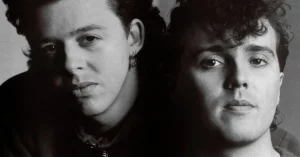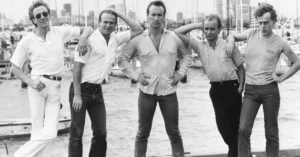Björk: The Sonic Alchemist of Avant-Garde Pop
Björk. From Reykjavík to the World: Origins and Early Years
Björk Guðmundsdóttir, known globally by her first name, was born on November 21, 1965, in Reykjavík, Iceland. A musical prodigy, she released her first solo album at just 11 years old—a folk-pop collection sung in Icelandic that foreshadowed her fearless creativity.
In the 1980s, she became part of Iceland’s post-punk and alternative scenes, joining bands like Tappi Tíkarrass, Kukl, and eventually the anarchic collective The Sugarcubes. With the Sugarcubes, Björk achieved international recognition thanks to hits like “Birthday,” which caught the attention of critics and indie labels abroad.
But it was her solo reinvention in the 1990s that marked the true beginning of one of music’s most daring and distinctive careers.
Björk. The Birth of a New Star: Debut (1993)
After moving to London, Björk launched her solo career with Debut (1993), a genre-blending album that fused electronic beats, jazz, house, and trip hop. Produced by Nellee Hooper (of Soul II Soul and Massive Attack fame), Debut was experimental yet accessible.
Key tracks:
- “Human Behaviour” – An abstract, tribal rhythm-driven anthem about primal instincts.
- “Venus as a Boy” – Delicate and sensual, underscoring her signature blend of innocence and mystery.
- “Big Time Sensuality” – A club-ready celebration of joy and freedom, paired with an iconic music video.
Debut was both critically acclaimed and commercially successful, immediately positioning Björk as a visionary outsider in the pop landscape.
Expanding the Palette: Post (1995)
Her follow-up album, Post, was even more ambitious. Incorporating big band sounds, IDM (intelligent dance music), industrial textures, and cinematic ballads, it became a defining work of ’90s experimental pop.
Standout songs include:
- “Army of Me” – A thundering industrial anthem,
- “Hyperballad” – A poetic and surreal exploration of love and emotional release,
- “It’s Oh So Quiet” – A playful, jazz-inspired number that showed off her theatrical side.
Post cemented Björk’s reputation as a fearless musical shapeshifter unafraid to challenge genre boundaries or pop norms.
Sonic Sculpture: Homogenic (1997)
With Homogenic, Björk created an album that was both deeply emotional and thematically unified. Backed by lush string arrangements and raw electronic beats, the album was inspired by Iceland’s natural landscapes—volcanic, icy, and majestic.
Highlights:
- “Jóga” – A tribute to her homeland and best friend, combining orchestral grandeur with glitchy beats.
- “Bachelorette” – A gothic, sweeping track with a surreal music video directed by Michel Gondry.
- “All Is Full of Love” – A futuristic love song whose robotic visuals and ambient sound have become iconic.
Homogenic is widely considered one of the greatest albums of the 1990s, a perfect synthesis of organic emotion and digital experimentation.
Breaking Boundaries: Selmasongs and Dancer in the Dark (2000)
Björk starred in Lars von Trier’s film Dancer in the Dark (2000), playing a blind factory worker in a tragic musical. Her performance won the Best Actress award at Cannes, though the shoot was infamously grueling.
She also composed the film’s score (Selmasongs), blending industrial noise and musical theater into a haunting soundtrack. The song “I’ve Seen It All,” performed with Thom Yorke, earned an Academy Award nomination.
Biophilia and Beyond: Albums as Ecosystems
Each of Björk’s albums since the early 2000s has explored new technological, emotional, and philosophical terrain:
Vespertine (2001)
An intimate, wintery album built from microbeats, harps, and whispered vocals. A meditation on love, domesticity, and inner life.
Medúlla (2004)
Constructed almost entirely with the human voice—beatboxing, choral singing, throat singing. A primal yet futuristic sonic experiment.
Volta (2007)
A colorful, politically charged album featuring brass orchestras and tribal percussion. Collaborations included Antony Hegarty and Timbaland.
Biophilia (2011)
An ambitious multimedia project combining music, apps, science, and education. Each song corresponded to a natural or cosmic phenomenon.
Vulnicura (2015)
A devastating breakup album chronicling the end of her relationship with artist Matthew Barney. Raw, orchestral, and emotionally exposed.
Utopia (2017)
A hopeful, flute-driven album imagining a post-human, matriarchal paradise. Filled with birdsong, breath, and Björk’s idealism.
Fossora (2022)
Inspired by motherhood, fungi, and Icelandic soil. Features bass clarinets, gabber beats, and guest vocals from her daughter, Ísadóra.
Björk. A Multimedia Visionary
Björk isn’t just a musician—she’s a full-spectrum artist. From her iconic swan dress at the 2001 Oscars to her work with fashion designers like Alexander McQueen and Iris van Herpen, Björk treats her body and image as an extension of her art.
She has also pushed the boundaries of music videos—working with directors like Michel Gondry, Chris Cunningham, and Spike Jonze—and has consistently embraced technology and science, from virtual reality experiences to custom-made apps.
Björk. Legacy and Influence
Björk’s impact is immeasurable. She has:
- Inspired artists like FKA twigs, Grimes, Arca, and Caroline Polachek,
- Redefined what it means to be a pop artist, particularly as a woman in control of her image and sound,
- Bridged the gap between mainstream music and avant-garde art.
With over 30 million albums sold, multiple Grammy and BRIT nominations, and an ever-growing body of work that refuses to settle or simplify, Björk remains a singular voice in modern music.

Björk. Final Thoughts: The Alchemy of Emotion and Innovation
Björk’s career is an ongoing experiment—one where vulnerability meets intellect, and nature dances with the machine. Each project she embarks on is not just an album, but a world unto itself.
Whether whispering a lullaby or commanding a digital symphony, Björk continues to redefine what music can be—and what the artist can become.





